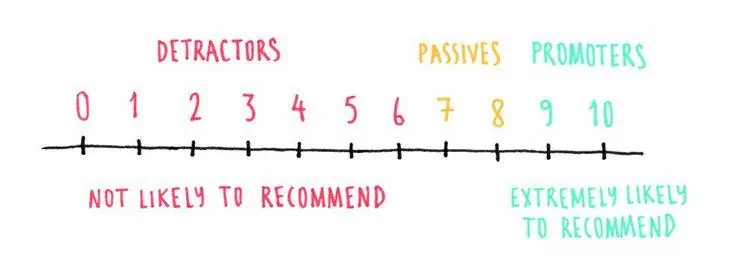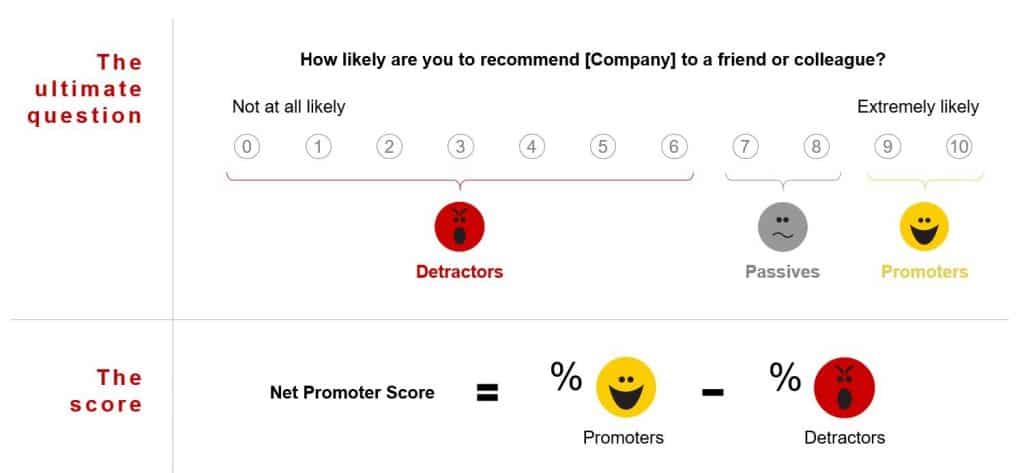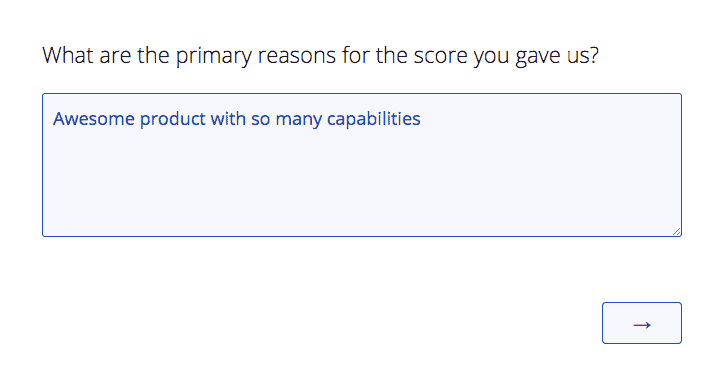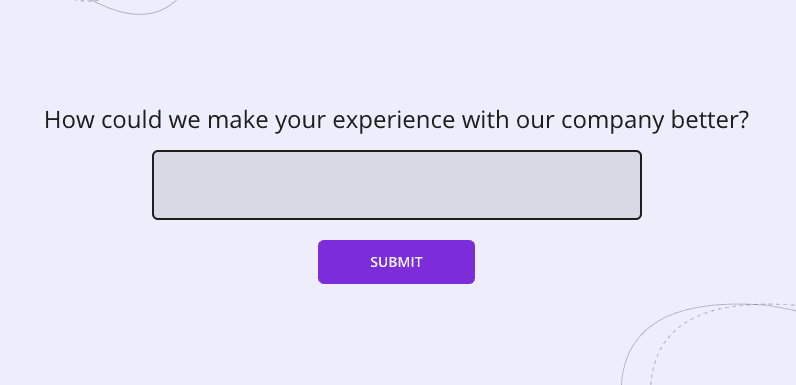The Net Promoter Score (NPS) is the most widely used statistic for gauging customer happiness and loyalty around the globe. It extends beyond determining a customer’s level of satisfaction with a firm to determining their desire to promote it to others. Let’s dig deeper into what is NPS and why it is important.
Definition of Net Promoter Score
Net Promoter Score (NPS) is frequently regarded as the gold standard in customer experience metrics. It was created in 2003 by Bain and Company and is now used by millions of businesses to measure and track how their customers perceive them.
Net Promoter Score (NPS) is a measure used in customer experience projects. NPS assesses a company’s customers’ loyalty. It is quantified by asking the ultimate question “on a scale from 0-10, how likely are you to recommend this company to a friend or colleague?” which allows firms to monitor promoters and detractors, resulting in a clear gauge of an organization’s performance through the eyes of its consumers.
According to Bain’s research, persistent value creators—companies that achieve long-term profitable growth—have double the NPS of ordinary organisations. And, according to Bain’s Net Promoter System, leaders grow at more than twice the rate of competitors.

Net Promoter Score Scale: Detractors, Passives, Promoters
Customers are classified as promoters, detractors, or passives in the Net Promoter system based on how they respond to the question “how likely are you to recommend us” question:

Promoters (scores of 9 and 10) are a company’s most passionate and loyal customers. These individuals are more likely to act as brand ambassadors, improve a brand’s reputation, and increase referral flows, so fueling the company’s growth.
Passives (scores of 7 or 8) do not actively endorse a brand, but they are also unlikely to harm it through unfavourable word of mouth. Although they are not included in the NPS calculation, passives are extremely near to being promoters (especially when they provide a score of 8), therefore it is always advantageous to spend time researching how to win them over.
Detractors (scores ranging from 0 to 6) are reluctant to suggest a firm or product to others, are unlikely to remain around or make repeat purchases, and, worse, may actively prevent potential consumers from visiting a business.
How to Calculate NPS
After answering the ultimate question, grade the answers on a scale of 0 to 10. Your Net Promoter Score is just the proportion of customers who are promoters (those who scored 9 or 10) minus the proportion of customers who are detractors (those who scored 0 to 6).

Measuring your Net Promoter Score provides you with a figure that you can create and follow on a regular basis, not just for a company as a whole, but also for each business, product, shop, or customer service team. It is also possible to track it for consumer segments, geographic areas, or functional groupings. It assists everyone in focusing on the twin goal of increasing promoters and decreasing detractors. Simply put, it is your customer balance sheet.
Why is NPS Important?
NPS may be used to forecast business growth. When your company’s NPS is high (or, at the very least, greater than the industry average), you know you have a healthy relationship with consumers who are likely to serve as brand advocates, drive word of mouth, and create a positive growth cycle.
On a strategic level, NPS is a helpful statistic; yet, the score alone is insufficient to be meaningful or to present a whole picture. The NPS system as a whole is essential since it enables firms to:
- Ask follow-up questions. Organizations of any size may learn what they’re doing well and where they might improve by asking consumers why they gave a certain grade.
- Create internal benchmarks by tracking and quantifying a score over time.
- Gather all staff around a single mission-critical goal: gaining more passionate consumers
How to Create an NPS Survey?
NPS surveys are generally simple to develop, but you must think about the long-term data use when deciding how you’ll administer them. You could utilise survey software, but because it only measures one statistic, you will be limited in your ability to act on the data.
To gain a complete picture of your consumers, we recommend employing a Customer Experience Management Platform or NPS software. Customer experience management tools enable you to keep track of all interactions your firm has with present and future consumers. You may then utilise NPS data to determine which touchpoints have high NPS scores and which have poor NPS scores.
Questions to Ask in an NPS Survey
Demographic Questions
It’s not unusual for an NPS survey to begin with demographic questions such as age, gender, income, and so on. This response data might be useful when segmenting your data during study and analysis. Avoid including demographic questions in the survey if they are unnecessary, since you may collect the answers from data already stored in other systems, such as a CRM or customer database. Remember that the fewer survey questions you ask, the better.
The Net Promoter Score Question

This is the main question we discussed before, and it will be the major method you determine your score. The additional questions below are used to help analyse the data and follow up with the responder to address their criticism.
Reason For Your Score?
In this open text question, you ask the consumer why they gave a numerical score in the preceding question. This will assist you in identifying the motivators for promoters and critics in your comments. Going through open text feedback can be time-consuming, so consider utilising a text analysis tool. A text analysis tool will save you a lot of time if you have more than a few dozen answers in your distribution.

How Can We Make Your Experience Better?
In this question, you ask the responder to suggest ways to improve their experience. If you want to undertake close-loop follow up and customer ticketing with your replies, this can be useful. If you already know the answer, you’re halfway to fixing the problem directly with the consumer.
Remember that not all situations will require both the “reason for your score” and “how could we better” questions, since they will often have the same response. For example, if the reason they gave a low score was “extended call waiting times,” the most likely method to improve the experience would be to “shorten wait times.”

Permission To Follow up With The Customer
It’s a good idea to ask the survey responder whether you may contact them again if necessary. Not everyone will want to talk to someone about their problem. Depending on how your survey was disseminated, you may or may not have the customer’s email or phone number, so don’t be afraid to request it if necessary. Similar to the demographic question, don’t ask for this information if you can access their contact information using metadata from another source.
Advantages & Disadvantages of NPS
We all know that the NPS score has the ability to assess your consumers’ loyalty. You can determine whether or not your customers are facing troubles by asking a single question. One of the numerous reasons why organisations enjoy computing the Net Promoter Score is its ease.
However, we cannot conclude that the NPS score is a flawless tool for gauging your client experience. It has its limits as well as its advantages. Here are the advantages and disadvantages of NPS:
| Advantages | Disadvantages |
|---|---|
| Simplicity at its Best | NPS Score Doesn’t Provide Deep Insights |
| Offers Feedback with Clarity | Don’t Depend Blindly |
| The Loyalty Metric | NPS Score Doesn’t Address Employee Issues |
Simplicity at its best. NPS surveys are unquestionably user-friendly in the eyes of your consumers. Customers appreciate it since it is quick, brief, and to the point. All they have to do is respond to a simple question: “How likely are they to refer your company/products/services to a friend?” That’s all there is to it; they’re ready to go!
From a commercial standpoint, the NPS score allows you to simply categorise your customers into three groups (detractors, promoters, and passives). Because NPS questions are simple, you can easily examine the findings. You can quickly measure, benchmark, and compare your performance to those of your competitors.
Offers feedback with clarity. Net Promoter Score provides more detailed feedback than any other survey approach. The NPS survey is brief and to the point. This encourages your respondents to provide comments without becoming bored. When a survey becomes too long and uninteresting, people prefer to quit it. And it’s always advantageous for your company to get client feedback in a clear manner.
The loyalty metric. NPS is a prominent loyalty statistic that allows you to assess your customers’ loyalty. You can learn how likely your consumers are to promote your brand to their friends and family by using a Net Promoter Score. As a result, NPS plays a significant part in establishing word-of-mouth marketing. According to the Neilsen research, 92 percent of buyers trust recommendations from friends and family above advertising.
Customers who come via recommendations and referrals are more loyal and profitable for businesses. As a result, if you receive a high NPS score from your brand advocates, you can simply identify who is more likely to spread the word about you.
However, here are a few disadvantages of NPS that you should be aware of the next time you use it:
NPS score doesn’t provide deep insights.
It does not provide detailed information about your customers, stakeholders, workers, and, most importantly, prospective customers. With an NPS score, you can only pose one question: “What someone is likely to do?”
And that isn’t enough to comprehend why someone rated you positively or negatively. You don’t get to ask them why they prefer doing business with you, what your shortcomings are, and how you might improve in the future.
Don’t depend blindly. Net promoter score surveys are, in fact, quite simple and quick to use. Most businesses depend much too heavily on NPS rankings to gauge their consumers’ loyalty.
The fact is that NPS ratings aren’t a magic wand that can keep consumers satisfied with a single query. It is impossible to thoroughly comprehend your clients’ emotions. So, don’t rely just on the NPS score. Also, don’t dismiss the importance of conducting customer feedback surveys because NPS alone won’t provide you with all of the specifics about a customer’s individual experience with your business.
NPS score doesn’t address employee issues.
NPS scores do not have the capacity to help you understand your staff. You can ask them to rank your organisation on a scale of 1 to 10, but you cannot inquire about their sentiments and well-being.
Especially after the Covid-19 epidemic, it has been critical to inquire about employees’ well-being and mental health. Approximately 5.5 million employees did not feel psychologically well throughout this period.
However, just half of the employees feel comfortable expressing their mental health difficulties. But workers can’t express themselves through ratings. They require something additional in order to express themselves more fully.
Conclusion
Net Promoter Score (NPS) have both advantages and disadvantages to it. At the end of the day, if a company utilises NPS correctly, it will definitely help the company in understanding its audience better. Here is a video for you to understand more about Net Promoter Score:
References
Measuring Your Net Promoter Score
Net Promoter Score® calculation
The Advantages and Disadvantages of Net Promoter Score (NPS)